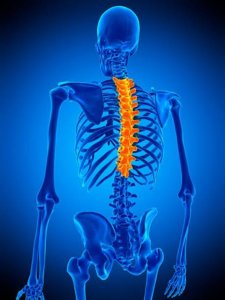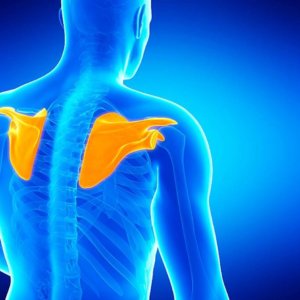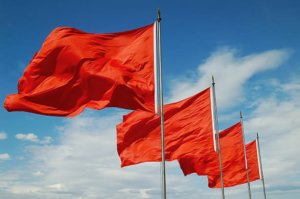COVID-19 PATIENT GUIDELINES
COVID-19 PATIENT GUIDELINES Please click on the link to review our office guidelines in response
keep readingLet’s look at Ribcage Anatomy
(12 Thoracic Vertebrae, 12 Ribs, Scapula)

 As you can see, the scapula sits on top of the upper third of the ribcage which is attached to the thoracic spine. The interplay of these 3 major structures is important when talking about overhead biomechanics as there are a lot of moving parts. To keep it simple the spine needs to be flexible for the scapula to be able to slide and glide along the ribs, creating shoulder movement. We will dive into the complexity of shoulder movement in future articles but it is important to keep the shoulder in mind when talking about scapulothoracic biomechanics as it has a direct effect on how the shoulder operates.
As you can see, the scapula sits on top of the upper third of the ribcage which is attached to the thoracic spine. The interplay of these 3 major structures is important when talking about overhead biomechanics as there are a lot of moving parts. To keep it simple the spine needs to be flexible for the scapula to be able to slide and glide along the ribs, creating shoulder movement. We will dive into the complexity of shoulder movement in future articles but it is important to keep the shoulder in mind when talking about scapulothoracic biomechanics as it has a direct effect on how the shoulder operates.
The functional joint that is formed between the ribcage and scapula is called the scapulothoracic junction. In order for the scapula to be able to posteriorly tilt and upwardly rotate as the arm is moved upwards the thoracic spine needs to create a flat surface for this to occur. This extension (flattening of the thoracic curve) creates a flat enough surface for the scapula to be able to swing up and around allowing the shoulder to get overhead.
To create a clearer picture in how this relates to pitching is this is what allows an athlete to get into proper layback. The ability to get into layback efficiently and on-time without any compensatory movement is paramount to reducing the stress on the ulnar collateral ligament (UCL) in the elbow as well as the shoulder. Layback is a snapshot in the pitching motion where the pitcher’s shoulder is in the most externally rotated position in their delivery.

Patrick Corbin in Layback
Now that we know how the scapula should be moving along the ribcage what happens when something goes wrong along this kinetic chain?
I’ll discuss this in baseball vernacular in the red flag section as well as structurally in this section. A caveat to this conversation is that just because we see something in a snapshot picture does not necessarily mean that entire movement pattern is bad, but it does indicate we should evaluate how mechanically the athlete ended up in this position and how they get themselves out of it. You’ll see that there are many different styles to pitching in Major League Baseball and there isn’t a one size fits all solution. The red flags I will discuss next section are just common patterns we see with pitchers who end up on the injured list.
Typically when discussing the scapula it is good to think of it as the “core” of the shoulder as we do with our core for low back health. Typically if we have a weak core we are going to have low back pain and/or lower extremity issues. In the same vein if we have a weak shoulder blade we are going to have problems in our shoulder or the arm. The most important indicator of shoulder blade health is the ability to use our serratus anterior and lower trapezius to create overhead movement of our shoulder. The most common compensation pattern that we are going to see that would prevent this is someone with an overactive upper trapezius and levator scapulae which are downward rotators of the scapula. Typically symptoms of this would include front of the shoulder pain, stiffness/pain in the shoulder, and sometimes neck pain. Secondarily if someone has a stiff thoracic spine (mid back) and can’t get proper extension (flattening of the curve) the scapula has nowhere to go and the shoulder get stuck ¾ of the way overhead which requires compensation somewhere else to get the arm fully overhead. These symptoms present as a feeling of needing to “pop” the back, pain between the shoulder blades, and feeling of tightness in the mid back when moving around.
 Now that we have covered the general symptoms off of the field let’s talk about what it looks like on the diamond. I’m going to highlight the top 3 pitching red flags for simplicity. Red flags are defined as movements that have a high association to injury or increased injury risk. When it comes to red flags these issues can either be mechanical issues in the delivery or it could be a structural problem that needs to be identified by a medical professional like a Sports Chiropractor or Physical Therapist.
Now that we have covered the general symptoms off of the field let’s talk about what it looks like on the diamond. I’m going to highlight the top 3 pitching red flags for simplicity. Red flags are defined as movements that have a high association to injury or increased injury risk. When it comes to red flags these issues can either be mechanical issues in the delivery or it could be a structural problem that needs to be identified by a medical professional like a Sports Chiropractor or Physical Therapist.
Visually this can look a couple different ways. Typically what we will see is the arm lagging behind the rest of the body once we get into initial foot strike so flip up into layback is sped up and the ball is released as a push instead of whipping through the ball. This can put a lot of force into the medial elbow where the UCL lives as we cannot get the proper engagement out of the shoulder so the velocity of the pitch will come from the weaker forearm muscles.
This is a very easy one to identify as it looks at the relationship of the thoracic spine to the shoulder. Early flexion occurs when an athlete flexes the thoracic spine forward while trying to get into lay back. This is due to poor mobility in the thoracic spine so they are unable to keep the thoracic spine flattened as the shoulder is being brought overhead into the layback position. This is one of the most identifiable movements that are associated with elbow and shoulder injuries in baseball players. The reason for this is because the scapula doesn’t have the ability to upwardly rotate so the shoulder gets stuck in a vulnerable position, as a result external rotation of the shoulder gets very limited and layback in vastly impeded leading to over involvement of the elbow and shearing of the shoulder’s labrum.
Of the three this is the most interesting one because it is typically the result of the first 2 red flags. High hand is where the shoulder doesn’t externally rotate enough in layback. Ideally we want to get the ball as close to even with the elbow as possible as this reduces the forces exerted on the elbow. Late arm can cause this because the arm doesn’t have enough time to get into a deep externally rotated position due to being sped up as a result of being late. Early flexion can cause this because the shoulder is structurally blocked from being able to get high enough as well as externally rotate. Typically if I see a pitcher with a high hand I like to look at how they got into layback because the high hand is typically the product of a more sinister underlying problem.
Now that we know how many of these problems can happen the next question is how to treat them. This is enough information to be its own post. Check back in on Tuesday and we will go in depth on how to fix both the structural and mechanical problems associated with scapulothoracic dysfunction.
 Garrett Grant, DC
Garrett Grant, DC
Dr. Grant is an expert in the biomechanics of the overhead athlete as he stays up to date on the latest research involving throwing injury prevention as well as having a Pitching & Hitting certification through OnBaseUniversity. He also conducted a study on the incidence of Tommy John Surgery in the MLB during his time at Palmer College of Chiropractic. Coaching travel baseball for North Fairfax County Babe Ruth gives him real life applications of the concepts he employs in the clinic which helped his team qualify for the Virginia State Tournament this past summer.
Dr. Grant – Reston Office
Dr. Grant – Falls Church Office
Dr. Hirad Najafbagy, President of United Wellness & Sports Rehab is the team chiropractor for the Washington Nationals MLB Team.